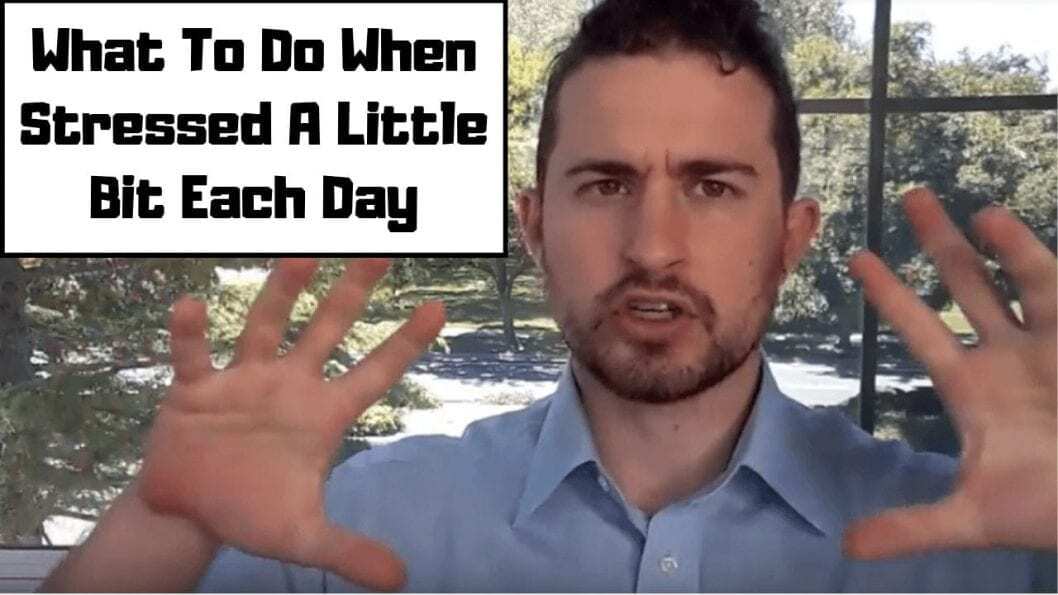Let’s talk about what to do when stressed …
But not your typical type of stress that you might think of:
- car accidents
- getting fired
- relationship fights
Those are stressful events, and learning how to handle them is important. However, this video is about a phenomena called “Low-Grade” stress.
The definition of low-grade stress is “Chronic stress is grinding stress. It wears people away day after day, year after year.
For example:
- you get 5 text messages in the middle of the night and the light from your phone wakes you up
- you get emails during lunch break when your mind should be resting
- your boss emails you after work
You get the idea, and I haven’t even mentioned stress, body image ideals, status considerations, etc.
This type of stress is what you experience everyday and here’s the problem:
Most people don’t deal with “low-grade stress” until it becomes high-grade stress.
Low-grade stress turns into high-grade stress when you get inexplicably angry and YELLLLL at someone. Or when you sudden quit projects in passive aggressive rage.
(I’ve been there)
Let’s understand why people don’t react and treat low-grade stress, until it’s oftentimes too late.
It all boils down to time, and how much you feel your time is worth.
Oftentimes people perceive that in order to decrease their stress, they need to spend time. This is partially true. For example, if you are stressed out and you go walk your dog , you’ll feel less stressed out.
However, walking your dog also takes time! 30 minutes or so, give or take. And oftentimes it’s the perceived time investment which prevents us from taking care of our selves.
Who wants to spend 30 minutes decreasing stress when there are so many other pressures in life – from unanswered emails, to texts, to projects, etc.
Basically relaxing and doing “traditional” self care takes a backseat because there are so many other pressures in life.
So in this video, I go in depth into how to solve this problem of time.
The simple answer is an answer I received from Laura Putnam in an interview I conducted with her, which you can view here https://youtu.be/Z4l7zcDKduE.
Laura Putnam is a celebrity productivity coach. She works with the Fortune 500 Companies to train their employees to be more productive and not burn out.
She uses a science based approach, and you can visit her website at https://www.motioninfusion.com/
I am going to sum up Lauren’s entire approach here:
Take little breaks during the day to decrease stress. Examples:
- walk to the printer that’s farther away from your desk and get a 1-2 minute breather
- spend a few minutes chatting
- get up and stretch
- take the stairs instead of the elevator
However, these aren’t the most interesting aspects of Lauren’s work.
What I think makes Lauren’s approach interesting is that she has tracked and cites science that shows these little breaks during the day actually make you much more productive.
The traditional reasoning is you just work, and that taking 1-10 minutes of “time off” is bad. However, work, work, work without breaks leads to a concept called “burnout” in which you take a massive amount of time off to recuperate.
Sometimes your body will force you to take a “time out” by forcing you to stress eat. Stress eating in this case, is simply your body forcing you to take a break from work, forcing you to turn your mind off.
The basic answer revolves understanding how to practice stress reduction skills.
Stress reduction skills can take very little time, although the downside is you have to practice these skills in order for them to be effective.
These stress reduction skills are more mental than physical, more mental training then physically decreasing your stress.
Let’s examine this point briefly.
- Physical stress reduction – you go on a walk. Take 30 minutes. Very basic. Anyone can do it. Effects are immediate and pretty tangible. Your stress might not go away, but you feel immediately better after going on a 30 minute walk.
- Mental stress reduction – you shift out of thinking and into feeling, noticing the intensity of your feelings and gaining clarity into where you are feeling stress and what type of stress. Wow. Just typing this sentence makes it seem complex. But basically you just take a moment to pause and feel your body. You can do this several times during the day.
So let’s talk about mental stress reduction real quick and try to make things very simple. In the video I go into more detail, but here’s the basic gist, which I’ve just explained to you above.



